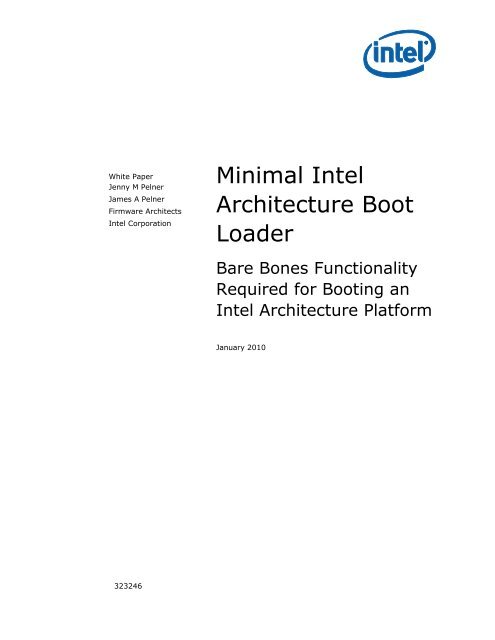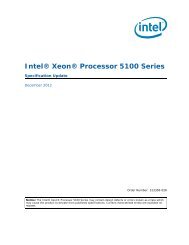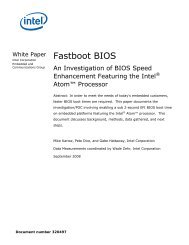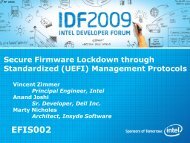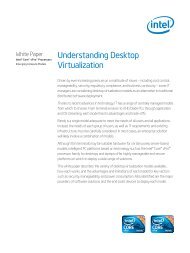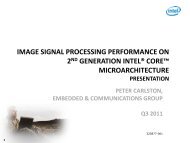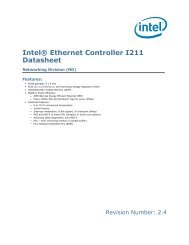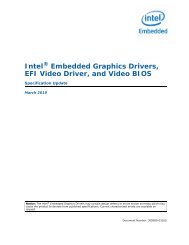Minimal Intel Architecture Boot Loader White Paper
Minimal Intel Architecture Boot Loader White Paper
Minimal Intel Architecture Boot Loader White Paper
Create successful ePaper yourself
Turn your PDF publications into a flip-book with our unique Google optimized e-Paper software.
<strong>White</strong> <strong>Paper</strong><br />
Jenny M Pelner<br />
James A Pelner<br />
Firmware Architects<br />
<strong>Intel</strong> Corporation<br />
<strong>Minimal</strong> <strong>Intel</strong><br />
<strong>Architecture</strong> <strong>Boot</strong><br />
<strong>Loader</strong><br />
Bare Bones Functionality<br />
Required for <strong>Boot</strong>ing an<br />
<strong>Intel</strong> <strong>Architecture</strong> Platform<br />
January 2010<br />
323246
2<br />
<strong>Minimal</strong> <strong>Boot</strong> <strong>Loader</strong> for <strong>Intel</strong>® <strong>Architecture</strong>
<strong>Minimal</strong> <strong>Boot</strong> <strong>Loader</strong> for <strong>Intel</strong>® <strong>Architecture</strong><br />
Executive Summary<br />
The intent of this <strong>White</strong> paper is to describe the minimal initialization<br />
steps that are necessary in order to boot to an <strong>Intel</strong> <strong>Architecture</strong> (IA)<br />
platform.<br />
The <strong>Intel</strong> ® Embedded Design Center provides qualified developers with<br />
web-based access to technical resources. Access <strong>Intel</strong> Confidential design<br />
materials, step-by step guidance, application reference solutions,<br />
training, <strong>Intel</strong>’s tool loaner program, and connect with an e-help desk<br />
and the embedded community. Design Fast. Design Smart. Get started<br />
today. www.intel.com/embedded/edc. §<br />
3
<strong>Minimal</strong> <strong>Boot</strong> <strong>Loader</strong> for <strong>Intel</strong>® <strong>Architecture</strong><br />
Contents<br />
Business Challenge (or Background) ........................................................................... 6<br />
Solution (Pilot Study or Proof of Concept) .................................................................... 6<br />
Initializing an <strong>Intel</strong> <strong>Architecture</strong> Platform from Reset .................................................... 6<br />
Power-Up (Reset Vector) Handling ........................................................... 7<br />
Mode Selection ...................................................................................... 7<br />
Real Mode ................................................................................... 7<br />
Flat Protected Mode ...................................................................... 7<br />
Segmented Protected Mode ........................................................... 8<br />
Initial Processor Mode ................................................................... 8<br />
Preparation for Memory Initialization ........................................................ 8<br />
Processor Microcode Update .......................................................... 8<br />
Processor Initialization .................................................................. 8<br />
Chipset Initialization ..................................................................... 9<br />
Memory Initialization .............................................................................. 9<br />
Technical Resources ..................................................................... 9<br />
MRC Dependencies ..................................................................... 10<br />
Post Memory Initialization ..................................................................... 10<br />
Memory Test ............................................................................. 11<br />
Firmware Shadow ...................................................................... 11<br />
Memory Transaction Re-Direction ................................................. 11<br />
Stack Setup .............................................................................. 12<br />
Transfer to DRAM ....................................................................... 12<br />
Miscellaneous Platform Enabling ............................................................ 12<br />
Interrupt Enabling ................................................................................ 12<br />
Programmable Interrupt Controller (PIC) ....................................... 12<br />
Local Advanced Programmable Interrupt Controller (LAPIC) ............. 13<br />
I/O Advanced Programmable Interrupt Controller (IOxAPIC) ............ 13<br />
Message Signaled Interrupt (MSI) ................................................ 13<br />
Processor Interrupt Modes ..................................................................... 13<br />
PIC Mode .................................................................................. 13<br />
Virtual Wire Mode ...................................................................... 13<br />
Interrupt Vector Table (IVT) .................................................................. 14<br />
Interrupt Descriptor Table (IDT) ............................................................. 14<br />
Exceptions ................................................................................ 14<br />
Real Mode Interrupt Service Routines (ISRs) ................................. 14<br />
Timers 14<br />
Programmable Interrupt Timer (PIT)............................................. 14<br />
High Precision Event Timer (HPET) ............................................... 14<br />
Real Time Clock (RTC) ................................................................ 15<br />
System Management TCO Timer .................................................. 15<br />
4
<strong>Minimal</strong> <strong>Boot</strong> <strong>Loader</strong> for <strong>Intel</strong>® <strong>Architecture</strong><br />
Local APIC (LAPIC) Timer ............................................................ 15<br />
Memory Caching Control ....................................................................... 15<br />
Processor Discovery and Initialization ..................................................... 16<br />
CPUID – Threads and Cores ......................................................... 16<br />
Startup Inter-Processor Interrupt (SIPI) ........................................ 17<br />
AP Wakeup State ....................................................................... 17<br />
Wakeup Vector Alignment ........................................................... 17<br />
Caching Considerations ............................................................... 17<br />
AP Idle State ............................................................................. 17<br />
I/O Devices ......................................................................................... 18<br />
Embedded Controller (EC) ........................................................... 18<br />
Super IO (SIO) .......................................................................... 18<br />
Legacy Free Systems .................................................................. 18<br />
Miscellaneous IO Devices ............................................................ 18<br />
PCI Device Discovery ............................................................................ 18<br />
<strong>Boot</strong>ing a Legacy OS ............................................................................ 20<br />
Memory Map ....................................................................................... 21<br />
Region Types ............................................................................. 21<br />
Region Locations ........................................................................ 22<br />
Non-Volatile (NV) Storage ..................................................................... 22<br />
Complimentary Metal-Oxide Semiconductor (CMOS) ....................... 22<br />
Non-Volatile Flash ...................................................................... 22<br />
References ............................................................................................................ 23<br />
Conclusion ............................................................................................................ 24<br />
5
Business Challenge (or Background)<br />
If a developer wants to write their own BIOS on IA architecture, then they<br />
have to gather the appropriate documents (which aren’t always known) and<br />
guess the order that the items listed must be done in.<br />
There currently isn’t one document that describes all the items that need to<br />
be done in one place, nor is the order of initialization described anywhere.<br />
There are also many legacy devices that must be initialized and finding<br />
documentation on them is challenging.<br />
This document is an attempt to document the order, the minimum steps<br />
required, and generate a central repository of the various documents that<br />
contain the technical details of each technology / component of a typical<br />
platform.<br />
Solution (Pilot Study or Proof of<br />
Concept)<br />
There are two approaches that are typically taken by <strong>Intel</strong> when a new<br />
platform is developed and a boot loader solution is required.<br />
<br />
<br />
A BIOS is employed<br />
A custom boot loader is developed<br />
The driving factor for the decision between the two is typically based on the<br />
features that are desired. BIOS has all the features and configurability<br />
available, whereas, a custom boot loader may work only for a specific board<br />
with specific hardware.<br />
Initializing an <strong>Intel</strong> <strong>Architecture</strong><br />
Platform from Reset<br />
The bare minimum firmware requirements for making an IA platform<br />
operational and booting an OS are presented here in an order recommended<br />
by the authors. There may be design-based or segment-based requirements<br />
which would add/delete/re-order many of the items presented in this paper.<br />
However, for the vast majority of system designs, these steps in this order<br />
are sufficient.<br />
323246
<strong>Minimal</strong> <strong>Boot</strong> <strong>Loader</strong> for <strong>Intel</strong>® <strong>Architecture</strong><br />
Power-Up (Reset Vector) Handling<br />
When an IA bootstrap processor (BSP) powers on, the first address that is<br />
fetched and executed is at physical address 0xFFFFFFF0, also known as the<br />
reset vector. This accesses the ROM / Flash device at the top of the ROM –<br />
0x10. The boot loader must always contain a jump to the initialization code<br />
in these top 16 bytes.<br />
Mode Selection<br />
The processor must be placed into one of the following modes:<br />
<br />
<br />
<br />
Real Mode<br />
Flat Protected Mode<br />
Segmented Protected Mode – Not Recommended for Firmware<br />
Refer to the <strong>Intel</strong>® 64 and IA-32 <strong>Architecture</strong>s Software Developer’s Manual<br />
Volume 3A section titled “Mode Switching” for more details.<br />
Real Mode<br />
Real Mode is 16-bit code with 16-bit registers. The physical address is<br />
calculated by SS
<strong>Minimal</strong> <strong>Boot</strong> <strong>Loader</strong> for <strong>Intel</strong>® <strong>Architecture</strong><br />
Segmented Protected Mode<br />
Segmented Protected Mode is typically used by Operating Systems in<br />
conjunction with paging mode. It is not practical for use by Firmware.<br />
Initial Processor Mode<br />
When the processor is first powered-on, it will be in a special mode similar to<br />
Real Mode, but with the top 12 address lines being asserted high, allowing<br />
boot code to be accessed directly from NVRAM (physical address<br />
0xFFFxxxxx). Upon execution of the first long jump, these 12 address lines<br />
will be driven according to instructions by firmware. If one of the Protected<br />
Modes is not entered before the first long jump, the processor will enter Real<br />
Mode, with only 1MB of addressability. In order for Real Mode to work<br />
without memory, the chipset needs to be able to alias memory below 1MB to<br />
just below 4GB, to continue to access NVRAM. Some chipsets do not have<br />
this aliasing and a forcible switch to a normal operating mode will be required<br />
before performing the first long jump.<br />
Preparation for Memory Initialization<br />
The following code is executed from the ROM / Flash since memory is not<br />
available yet. The least amount of code in this section the better, since<br />
executing from ROM is slow.<br />
The following are steps that are taken to get the system ready to initialize<br />
memory:<br />
<br />
<br />
<br />
Processor Microcode Update<br />
Processor Initialization<br />
Chipset Initialization<br />
Processor Microcode Update<br />
Refer to the <strong>Intel</strong>® 64 and IA-32 <strong>Architecture</strong>s Software Developer’s Manual<br />
Volume 3A section titled “Microcode Update Facilities” for details on applying<br />
a processor microcode update.<br />
Processor Initialization<br />
Refer to the applicable processor BIOS/Firmware Writer’s Guide for details on<br />
things that must be initialized prior to memory initialization, as well as, refer<br />
to the chipset Memory initialization Reference Code (MRC) documentation for<br />
any processor modes that must be initialized prior to calling the MRC.<br />
The following are all different requirements that may be applicable:<br />
8
<strong>Minimal</strong> <strong>Boot</strong> <strong>Loader</strong> for <strong>Intel</strong>® <strong>Architecture</strong><br />
<br />
<br />
<br />
<br />
Non-Evict Mode (NEM)<br />
SRAM<br />
Register Storage<br />
Stack-less Setup<br />
Chipset Initialization<br />
Refer to the Chipsets BIOS Writer’s Guides (BWG) for details on all<br />
initialization steps that must be performed prior to memory initialization.<br />
In general, all Base Address Registers (BARs) should be initialized prior to<br />
memory initialization.<br />
On most Integrated Controller Hubs / Integrated Output Hubs (ICHs / IOHs),<br />
there is a Watch Dog Timer (WDT) that must be disabled prior to the<br />
execution of memory initialization. If the WDT is not disabled, then a random<br />
reset can occur.<br />
Memory Initialization<br />
Technical Resources<br />
Memory initialization for <strong>Intel</strong> platforms differs widely from chipset to chipset.<br />
The details about how to initialize the memory subsystem is considered<br />
restricted collateral. It comes in two forms:<br />
<br />
<br />
Documentation (Chipset BIOS Writer’s Guide)<br />
Memory initialization Reference Code (MRC)<br />
The BIOS/Firmware Writer’s Guide documents the minimal steps required to<br />
initialize the memory subsystem as well as the boundaries/restrictions of the<br />
subsystem. This is useful for vendors that choose to write the memory<br />
initialization code themselves.<br />
The MRC is distributed in different forms (depending on the owning <strong>Intel</strong><br />
division and the platform). Each form that may be available is a fullyfunctioning<br />
implementation of the algorithm in the BIOS/Firmware Writer’s<br />
Guide. The MRC may be ported into any firmware stack with a minimal<br />
amount of effort. Since the MRC supports all technologies and configurations<br />
allowed on a platform, it is possible to trim down the MRC to fit a vendor’s<br />
design in a minimal amount of code space. This is the vendor’s responsibility<br />
and not directly supported by <strong>Intel</strong>.<br />
9
<strong>Minimal</strong> <strong>Boot</strong> <strong>Loader</strong> for <strong>Intel</strong>® <strong>Architecture</strong><br />
MRC Dependencies<br />
In order to use MRC distributed by <strong>Intel</strong>, care needs to be taken to provide<br />
the appropriate operating environment for the code. The operating<br />
environment requirements may include (but may not be limited to):<br />
<br />
<br />
<br />
Processor Operating Mode<br />
Cache Configuration<br />
Memory Geometry Information<br />
MRC may be written to run in 16-bit Real Mode, 32-bit Flat Mode, or<br />
(unlikely) a 32-bit Segmented Mode. If the adopted code does not have the<br />
appropriate operating environment, performance cannot be guaranteed.<br />
With the higher DRAM speeds and the need for RCOMP and DLL calibration,<br />
typical chipsets do not have enough scratchpad space in the register sets.<br />
Therefore, it is common for MRC to have cache configuration requirements,<br />
such that the MRC has a “chalkboard” to write on during initialization.<br />
PC-based memory configurations are based on removable memory modules<br />
(DIMMs). These configurations are dynamically detectable through tiny<br />
EPROM chips on the DIMMs. These chips contain specification-defined<br />
information about the capability of the DRAM configuration on the DIMM<br />
(Serial Presence Detect Data, or SPD data), and is readable through an I2C<br />
interface. For chipsets that are intended to be used in PC-based systems and<br />
support DIMMs, the MRC will usually have native SPD detection support<br />
included. For non-PC-based systems, it may not be present. In these<br />
configurations, it is required to hardcode the memory configuration or provide<br />
access to the memory geometry information through any vendor-defined<br />
mechanism. For memory-down designs, it may be necessary to generate<br />
several bytes of SPD data based on the DRAM datasheets and the schematics<br />
for the platform, and provide that to the MRC.<br />
All of these dependencies should be documented along with the code that<br />
comprises the MRC.<br />
Post Memory Initialization<br />
There are certain things that must be done after MRC but before jumping and<br />
executing from memory. The following is a list of things that should be<br />
performed:<br />
<br />
<br />
<br />
<br />
Memory Test<br />
Shadow Firmware<br />
Memory Transaction Re-Direction (PAMs)<br />
Stack Setup<br />
10
<strong>Minimal</strong> <strong>Boot</strong> <strong>Loader</strong> for <strong>Intel</strong>® <strong>Architecture</strong><br />
<br />
Transfer to DRAM<br />
Memory Test<br />
At the end of memory initialization is the perfect time to attempt to perform some<br />
kind of memory integrity test. Some releases of MRC contain a memory test, and<br />
some do not. BIOS vendors typically provide some kind of memory test on a cold<br />
boot as well. Writing custom firmware will require the authors to choose a balance<br />
between thoroughness and speed, as highly embedded/mobile devices require<br />
extremely fast boot times.<br />
Why is this the best time to perform memory tests Simply because memory errors<br />
manifest themselves in very random ways, sometimes very inconsistently. Not<br />
checking memory integrity immediately after initializing memory increases complexity<br />
of firmware debug immensely, as any of the memory manipulation steps or firmware<br />
execution from DRAM is suspect to corruption.<br />
There are several types of memory tests that are done in industry. Typically simple<br />
memory tests are performed in BIOS. Simple because it decreases code<br />
size/complexity and is easy to implement in assembly language to be executed out of<br />
NVRAM. Server-based platforms may implement much more thorough and complex<br />
memory tests. This paper does not promote any algorithm in specific.<br />
Firmware Shadow<br />
The concept of shadowing is simple: take code from slow non-volatile<br />
storage and copy it to DRAM. Why Simply put, executing from DRAM is<br />
much faster. Cache misses that cause frequent fetches to non-volatile<br />
storage slows systems down greatly. Therefore it is recommended that<br />
system firmware is copied from non-volatile storage to DRAM as soon as<br />
possible after memory is initialized. Then, the non-volatile latency hit is only<br />
felt once.<br />
For PC-based systems, the shadow must be from non-volatile storage to<br />
somewhere in the upper part of the lower 1MB of system memory. For non-<br />
PC systems, the end location is arbitrary, and up to the vendor and the<br />
requirements of the overlying software stack. For most applications, it’s<br />
recommended to keep firmware code below 1MB.<br />
Memory Transaction Re-Direction<br />
<strong>Intel</strong> chipsets usually come with memory aliasing capabilities that allow reads<br />
and writes to sections of memory below 1MB to be either routed to/from<br />
DRAM or non-volatile storage located just under 4GB. The registers that<br />
control this aliasing are typically referred to as PAMs (Programmable Attribute<br />
Maps). Manipulation of these registers may be required before, during and<br />
after firmware shadowing. The control over the redirection of memory access<br />
varies from chipset to chipset. For example, some chipsets allow control over<br />
reads and writes, while others only allow control over reads. Consult the<br />
chipset datasheet for details on the memory redirection feature controls<br />
applicable to the target platform.<br />
11
<strong>Minimal</strong> <strong>Boot</strong> <strong>Loader</strong> for <strong>Intel</strong>® <strong>Architecture</strong><br />
Stack Setup<br />
The stack must be setup before jumping into memory. A memory location<br />
must be chosen for stack space. The stack will count down so the top of the<br />
stack must be entered and enough memory must be allocated for the<br />
maximum stack.<br />
If the system is in real mode, then SS:SP must be set with the appropriate<br />
values. If Protected Flat Mode is used, then SS:ESP must be set to the<br />
correct memory location.<br />
Transfer to DRAM<br />
This is where the code makes the jump into memory. As mentioned before, if<br />
a memory test has not been performed up until this point, the jump could<br />
very well be to garbage. System failures indicated by a POST code between<br />
“end of memory initialization” and the first following POST code, almost<br />
always indicates a catastrophic memory initialization problem.<br />
Miscellaneous Platform Enabling<br />
Miscellaneous things in the system must be configured in the boot loader for<br />
proper operation. The only way to know what has to be programmed is to<br />
review the schematics. The following things are typically required to be<br />
programmed, but it is platform dependent:<br />
<br />
<br />
Clock Chip programming<br />
GPIO configuration – Refer to the Chipset BIOS Writers Guide for more<br />
details.<br />
Interrupt Enabling<br />
IA has several different methods of interrupt handling. The following or a<br />
combination of the following can be used to handle interrupts:<br />
Programmable Interrupt Controller (PIC) or 8259<br />
<br />
<br />
<br />
Local Advanced Programmable Interrupt Controller (APIC)<br />
Input / Output Advanced Programmable Interrupt Controller (IOxAPIC)<br />
Messaged Signaled Interrupt (MSI)<br />
Programmable Interrupt Controller (PIC)<br />
The PIC contains two cascaded 8259s with fifteen available IRQs. IRQ2 is not<br />
available since it is used to connect the 8259s.<br />
12
<strong>Minimal</strong> <strong>Boot</strong> <strong>Loader</strong> for <strong>Intel</strong>® <strong>Architecture</strong><br />
Refer to the Chipset BIOS Writers Guide for more information on initializing<br />
the PIC.<br />
Local Advanced Programmable Interrupt Controller<br />
(LAPIC)<br />
The local APIC is contained inside the processor and controls the interrupt<br />
delivery to the processor. Each local APIC contains is own set of associated<br />
registers as well as a Local Vector Table (LVT). The LVT specifies the manner<br />
in which the interrupts are delivered to each processor core.<br />
Refer to the <strong>Intel</strong>® 64 and IA-32 <strong>Architecture</strong>s Software Developer’s Manual<br />
for more information on initializing the local APIC.<br />
I/O Advanced Programmable Interrupt Controller<br />
(IOxAPIC)<br />
The IOxAPIC is contained in the ICH / IOH and expands the number of IRQs<br />
available to 24. Each IRQ has an associated redirection table entry that can<br />
be enabled / disabled and selects the IDT vector for the associated IRQ. This<br />
mode is only available when running in protected mode.<br />
Refer to the Chipset BIOS Writers Guide for more information on initializing<br />
the IOxPIC.<br />
Message Signaled Interrupt (MSI)<br />
The boot loader does not typically use MSI for interrupt handling.<br />
Processor Interrupt Modes<br />
PIC Mode<br />
When the PIC is the only interrupt device enabled, it is referred to as PIC<br />
Mode. This is the simplest mode where the PIC handles all the interrupts. All<br />
APIC components are bypassed and the system operates in single-thread<br />
mode using LINT0.<br />
Virtual Wire Mode<br />
Virtual Wire Mode uses the one of the APICs to create a virtual wire and<br />
operates the same as PIC mode. Refer to the <strong>Intel</strong>® 64 and IA-32<br />
<strong>Architecture</strong>s Software Developer’s Manual Volume 3A for more details.<br />
13
<strong>Minimal</strong> <strong>Boot</strong> <strong>Loader</strong> for <strong>Intel</strong>® <strong>Architecture</strong><br />
Interrupt Vector Table (IVT)<br />
The IVT is the Interrupt Vector Table located at memory location 0p and<br />
containing 256 interrupt vectors. The IVT is used in real mode. Each vector<br />
address is 32 bits and consists of the CS:IP for the interrupt vector. Refer to<br />
the <strong>Intel</strong>® 64 and IA-32 <strong>Architecture</strong>s Software Developer’s Manual Volume<br />
3A section titled “Exception and Interrupt Reference” for a list of Real Mode<br />
interrupts / exceptions.<br />
Interrupt Descriptor Table (IDT)<br />
The IDT is the Interrupt Descriptor Table and contains the exceptions /<br />
interrupts in Protected Mode. There are also 256 interrupt vectors and the<br />
exceptions / interrupts are defined in the same locations as the IVT. Refer to<br />
the <strong>Intel</strong>® 64 and IA-32 <strong>Architecture</strong>s Software Developer’s Manual Volume<br />
3A for a detailed description of the IDT.<br />
Exceptions<br />
Exceptions are routines that run to handle error conditions. Examples are<br />
page fault, general protection fault, etc. At a minimum placeholders (dummy<br />
functions) should be used for each exception handler. Otherwise the system<br />
could exhibit unwanted behavior if an exception is encountered that isn’t<br />
handled.<br />
Real Mode Interrupt Service Routines (ISRs)<br />
Real mode ISRs are used to communicate information between the boot<br />
loader and the OS. For example INT10h is used for video services such as<br />
changing video modes, resolution, etc.<br />
There are some legacy programs and drivers that assume these real mode<br />
ISRs are available and directly call the INT routine.<br />
Timers<br />
Programmable Interrupt Timer (PIT)<br />
The PIT (8254) resides in the IOH / ICH and contains the system timer also<br />
referred to as IRQ0. Refer to Chipset Datasheet for more details.<br />
High Precision Event Timer (HPET)<br />
HPET resides in the IOH / ICH and contains three timers. Typically the boot<br />
loader does not need to do any initialization of HPET and the functionality is<br />
used only by the OS.<br />
14
<strong>Minimal</strong> <strong>Boot</strong> <strong>Loader</strong> for <strong>Intel</strong>® <strong>Architecture</strong><br />
Refer to Chipset BIOS Writers Guide for more details.<br />
Real Time Clock (RTC)<br />
The RTC resides in the IOH / ICH and contains the system time (seconds /<br />
minutes / hours / etc). These values are contained in CMOS which is<br />
explained later in the document. The RTC also contains a timer that can be<br />
utilized by Firmware.<br />
Refer to the appropriate Chipset Datasheet for more details.<br />
System Management TCO Timer<br />
The TCO timers reside in the IOH / ICH and contain the Watch Dog Timer<br />
(WDT). The WDT can be used to detect system hangs and will reset the<br />
system.<br />
Note: It is important to note that for debugging any type of firmware on IA<br />
chipsets that implement a TCO Watch Dog Timer that it should be disabled by<br />
firmware as soon as possible coming out of reset. Halting system for debug<br />
prior to disabling this Watch Dog Timer on chipsets that power-on with this<br />
timer enabled will result in system resets, which doesn’t allow firmware<br />
debug. The OS will re-enable the Watch Dog if it so desires. Consult the<br />
chipset datasheet for details on the specific implementation of the TCO Watch<br />
Dog Timer.<br />
Refer to the Chipset BIOS Writer’s Guide for more details.<br />
Local APIC (LAPIC) Timer<br />
The Local APIC contains a timer that can be used by Firmware. Refer to the<br />
<strong>Intel</strong>® 64 and IA-32 <strong>Architecture</strong>s Software Developer’s Manual Volume 3A<br />
for a detailed description of the Local APIC timer.<br />
Memory Caching Control<br />
Memory regions that must have different caching behaviors applied will vary<br />
from design to design. In the absence of detailed caching requirements for a<br />
platform, the following guidelines provide a “safe” caching environment for<br />
typical systems:<br />
<br />
<br />
Default Cache Rule – Uncached.<br />
00000000-0009FFFF – Write Back.<br />
15
<strong>Minimal</strong> <strong>Boot</strong> <strong>Loader</strong> for <strong>Intel</strong>® <strong>Architecture</strong><br />
<br />
<br />
<br />
<br />
<br />
<br />
000A0000-000BFFFF – Write Combined or Uncached.<br />
000C0000-000FFFFF – Write Back or Write Protected.<br />
00100000-TopOfMemory – Write Back.<br />
TSEG – Uncached.<br />
Graphics Stolen Memory – Write Combined or Uncached.<br />
Hardware Memory-Mapped I/O (e.g. PCI devices) – Uncached.<br />
The <strong>Intel</strong>® 64 and IA-32 <strong>Architecture</strong>s Software Developer’s Manual Volume<br />
3A section on “Memory Cache Control” contains all the details on configuring<br />
caching for all memory regions.<br />
See the appropriate Chipset BIOS Writer’s Guide for caching control<br />
guidelines specific to the chipset.<br />
Processor Discovery and Initialization<br />
CPUID – Threads and Cores<br />
Since <strong>Intel</strong> processors are packaged in various configurations, there are<br />
different terms that must be understood when considering processor<br />
initialization:<br />
<br />
<br />
<br />
Thread – A logical processor that shares resources with another logical<br />
processor in the same physical package.<br />
Core – A processor that coexists with another processor in the same<br />
physical package that does not share any resources with other processors.<br />
Package – A “chip” that contains any number of cores and threads.<br />
Threads and Cores on the same package are detectable by executing the<br />
CPUID instruction. See the <strong>Intel</strong>® 64 and IA-32 <strong>Architecture</strong>s Software<br />
Developer’s Manual Volume 2A for details on the information available with<br />
the CPUID instruction on various processor families.<br />
Detection of additional packages must be done “blindly”. If a design must<br />
accommodate more than one physical package, the BSP needs to wait a<br />
certain amount of time for all potential APs in the system to “log in”. Once a<br />
timeout occurs or the maximum expected number of processors “log in”, it<br />
can be assumed that there are no more processors in the system.<br />
16
<strong>Minimal</strong> <strong>Boot</strong> <strong>Loader</strong> for <strong>Intel</strong>® <strong>Architecture</strong><br />
Startup Inter-Processor Interrupt (SIPI)<br />
In order to wake up secondary threads or cores, the BSP sends a SIPI to each<br />
thread and core. This SIPI is sent by using the BSP’s LAPIC, indicating the<br />
physical address that the Application Processor (AP) should start executing<br />
from. This address must be below 1MB of memory and be aligned on a 4KB<br />
boundary.<br />
AP Wakeup State<br />
Upon receipt of the SIPI, the AP will start executing the code pointed to by<br />
the SIPI message. As opposed to the BSP, when the AP starts code execution<br />
it is in Real Mode. This requires that the location of the code that the AP<br />
starts executing is located below 1MB.<br />
Wakeup Vector Alignment<br />
The starting execution point of the AP has another architectural restriction<br />
that is very important and is commonly forgotten. The entry point to the AP<br />
initialization code must be aligned on a 4KB boundary. Refer to the <strong>Intel</strong>®<br />
64 and IA-32 <strong>Architecture</strong>s Software Developer’s Manual Volume 3A section<br />
titled “MP Initialization Protocol Algorithm for <strong>Intel</strong> Xeon Processors.”<br />
The <strong>Intel</strong>® 64 and IA-32 <strong>Architecture</strong>s Software Developer’s Manual Volume<br />
3A section labeled “Typical AP Initialization Sequence” illustrates what is<br />
typically done in by the APs after receiving the SIPI.<br />
Caching Considerations<br />
Because of the different types of processor combinations and different<br />
attributes of shared processing registers between threads, care must be taken<br />
to ensure that the caching layout of all processors in the entire system remain<br />
consistent such that there are no caching conflicts.<br />
The <strong>Intel</strong>® 64 and IA-32 <strong>Architecture</strong>s Software Developer’s Manual Volume<br />
3A contains a section labeled “MTRR Considerations in MP Systems” that<br />
outlines a safe mechanism for changing the cache configuration in all systems<br />
that contain more than one processor. It is recommended that this be used<br />
for any system with more than one processor present.<br />
AP Idle State<br />
Behavior of APs during firmware initialization is dependent on the firmware<br />
implementation, but is most commonly restricted to short durations of<br />
initialization followed by entering a halt state with a HLT instruction, awaiting<br />
direction from the BSP for another operation.<br />
17
<strong>Minimal</strong> <strong>Boot</strong> <strong>Loader</strong> for <strong>Intel</strong>® <strong>Architecture</strong><br />
Once the firmware is ready to attempt to boot an OS, all AP processors must<br />
be placed back in their power-on state (“Wait-for-SIPI”), which can be<br />
accomplished by the BSP sending an INIT ASSERT IPI followed by an INIT<br />
DEASSERT IPI to all APs in the system (all except self). See the <strong>Intel</strong>® 64<br />
and IA-32 <strong>Architecture</strong>s Software Developer’s Manual Volume 3A for details<br />
on the INIT IPI, and the MultiProcessor Specification 1.4 for details on BIOS<br />
AP requirements.<br />
I/O Devices<br />
Refer to the board schematics to determine which IO devices are in the<br />
system. Typically a system will contain one or more of the following:<br />
Embedded Controller (EC)<br />
An Embedded controller is typically used in mobile or low power systems.<br />
The EC contains separate FW that controls the power management functions<br />
for the system as well as PS2 keyboard functionality. Refer to the specific EC<br />
data sheet for more details.<br />
Super IO (SIO)<br />
An SIO typically controls the PS2, serial, parallel, etc interfaces. Most<br />
systems still support some of the legacy interfaces rather than implementing<br />
a legacy free system. Refer to the specific SIO datasheet for details on<br />
programming information.<br />
Legacy Free Systems<br />
Legacy free systems use USB as the input device. If pre-OS keyboard<br />
support is required, then the legacy keyboard interfaces must be trapped.<br />
Refer to the IOH / ICH BIOS Specification for more details on legacy free<br />
systems.<br />
Miscellaneous IO Devices<br />
There may be other IO devices that require initialization by the boot loader.<br />
Refer to those device’s datasheets for programming information.<br />
PCI Device Discovery<br />
Peripheral Connect Interface (PCI) device discovery is a generic term that<br />
refers to detecting which PCI compliant devices are in the system. The<br />
discovery process assigns the resources needed by each device including the<br />
following:<br />
18
<strong>Minimal</strong> <strong>Boot</strong> <strong>Loader</strong> for <strong>Intel</strong>® <strong>Architecture</strong><br />
<br />
<br />
<br />
<br />
IO space<br />
Memory Mapped IO (MMIO) space<br />
IRQ assignment<br />
Expansion ROM detection and execution<br />
PCI device discovery applies to all the newer (non-legacy) interfaces such as<br />
PCI Express (PCIe), USB, SATA, SPI, etc devices. These newer interfaces all<br />
comply to the PCI specification.<br />
Refer to PCI Specification for more details. A list of all the applicable<br />
specifications is in the References section.<br />
Resource allocation. Resource allocation is the method of searching<br />
through the possible range of buses / devices / functions.<br />
1 When a Vendor ID (VID) / Device ID (DID) is found that is not all<br />
0xFFFFs, then resources are defined as follows:<br />
a. Write all 0xFFFFFFFFs to all Base Address<br />
Registers (BAR)s. Read the BAR back. Bit 0<br />
will give an indication as to whether this is an<br />
MMIO or IO request.<br />
i. If MMIO is requested (bit 0 is a 0),<br />
then the value read back indicates how<br />
much memory is requested. Reserve<br />
the appropriate memory and write the<br />
address assigned into the BAR.<br />
ii. IO – If IO is requested (bit 0 is a 1),<br />
then the value read back indicates how<br />
many bytes of IO are requested.<br />
Reserve that amount of IO and write<br />
the IO address assigned to the BAR.<br />
b. IRQs<br />
i. Refer to the Schematics to determine<br />
how the IRQ routing should occur for<br />
any PCI / PCIe slots or onboard<br />
devices.<br />
ii. For chipset PCI devices, the routing<br />
may be pre-determined in the Chipset<br />
Datasheet. Some chipsets allow<br />
control of the internal routing as well.<br />
Refer to the Chipset Datasheet for<br />
more details.<br />
iii. There are multiple things involved in<br />
IRQ routing when using the PIC. The<br />
devices are assigned to INTA – INTD<br />
which in turn gets assigned to PIRQA –<br />
19
<strong>Minimal</strong> <strong>Boot</strong> <strong>Loader</strong> for <strong>Intel</strong>® <strong>Architecture</strong><br />
PIRQH which gets mapped to IRQs in<br />
chipset specific registers (0x60-0x63,<br />
0x68-0x6B). Refer to the IOH / ICH<br />
BIOS Writers Guide and Chipset<br />
Datasheet for more details.<br />
a. Read the Expansion ROM address register. If<br />
it is non-zero, then there is an Expansion ROM<br />
(also referred to as an Option ROM, OROM)<br />
that needs executed.<br />
i. Video BIOS (vBIOS) is handled<br />
differently than typical OROMs.<br />
Typically it is executed prior to PCI<br />
enumeration in order to give certain<br />
display devices time to warm up. The<br />
vBIOS is 16-bit code that needs to run<br />
in real mode. The boot loader loads<br />
the vBIOS at C000:0 and jumps to<br />
address C000:3.<br />
ii. Typical OROMs get loaded after the<br />
vBIOS starting at C800:0 and can<br />
continue up to E000:0. This limits the<br />
number and size of OROMs that can<br />
exist in a particular system.<br />
iii. Some OROMs are also bootable such<br />
as Ethernet OROMs that have PXE<br />
support.<br />
<strong>Boot</strong>ing a Legacy OS<br />
<strong>Boot</strong>ing a legacy OS (non-EFI) consists of loading the first stage OS or OS<br />
boot loader in to memory location 7C0:0 and jumping to that location while<br />
the processor is in Real Mode.<br />
Master <strong>Boot</strong> Record (MBR). The MBR is located on the first sector of a<br />
partitioned mass storage device. It contains the partition table as well as<br />
code. The Internet has details and can be reference at<br />
http://en.wikipedia.org/wiki/Master_boot_record.<br />
OS Handover Requirements. Depending on the desired features that are<br />
enabled by the boot loader, there are different tables that the OS needs. The<br />
following is a list of those tables:<br />
<br />
<br />
<br />
Memory Map (INT15h / Function E820h)<br />
Programmable Interrupt Routing ($PIR)<br />
Multi-Processor Specification (_MP_)<br />
20
<strong>Minimal</strong> <strong>Boot</strong> <strong>Loader</strong> for <strong>Intel</strong>® <strong>Architecture</strong><br />
<br />
<br />
Simple Firmware Interface (SFI)<br />
Advanced Configuration and Power Interface (ACPI)<br />
SFI and ACPI tables are only needed if those features are enabled by the boot<br />
loader and required by the OS.<br />
The _MP_ table is needed if there is more than one <strong>Intel</strong> processing agent<br />
(thread or core) in the system. Details on the _MP_ table may be found in<br />
the MultiProcessor Specification.<br />
The $PIR table and interrupt-based Memory Map are almost always needed.<br />
Details on the $PIR table may be found in the $PIR Specification. The<br />
Memory map is discussed in more detail in the following sections.<br />
Memory Map<br />
In addition to defining the caching behavior of different regions of memory for<br />
consumption by the OS, it is also firmware’s responsibility to provide a “map”<br />
of the system memory to the OS so that it knows what regions are actually<br />
available for its consumption.<br />
The most widely used mechanism for a boot loader or an OS to determine the<br />
system memory map is to use Real Mode interrupt service 15h, function E8h,<br />
sub-function 20h (INT15/E820), which firmware must implement (one<br />
example of this is detailed at http://www.uruk.org/origgrub/mem64mb.html).<br />
Region Types<br />
There are several general types of memory regions that are described by this<br />
interface:<br />
<br />
<br />
<br />
<br />
<br />
<br />
<br />
Memory (1) – General DRAM available for OS consumption.<br />
Reserved (2) – DRAM address not for OS consumption.<br />
ACPI Reclaim (3) – Memory that contains all ACPI tables that firmware does not<br />
require run-time access to. See the applicable ACPI specification for details.<br />
ACPI NVS (4) – Memory that contains all ACPI tables that firmware requires runtime<br />
access to. See the applicable ACPI specification for details.<br />
ROM (5) – Memory that decodes to non-volatile storage (e.g. flash).<br />
IOAPIC (6) – Memory that is decoded by IOAPICs in the system (must also be<br />
uncached).<br />
LAPIC (7) – Memory that is decoded by Local APICs in the system (must also be<br />
uncached).<br />
21
<strong>Minimal</strong> <strong>Boot</strong> <strong>Loader</strong> for <strong>Intel</strong>® <strong>Architecture</strong><br />
Region Locations<br />
The following regions are typically reserved in a system memory map:<br />
<br />
<br />
<br />
<br />
<br />
<br />
<br />
00000000-0009FFFF – Memory<br />
000A0000-000FFFFF – Reserved<br />
00100000- – Memory (The indicates that the top of<br />
memory changes based on “reserved” items listed below and any other<br />
design-based reserved regions.)<br />
TSEG – Reserved<br />
Graphics Stolen Memory – Reserved<br />
FEC00000-FEC01000* – IOAPIC<br />
FEE00000-FEE01000* – LAPIC<br />
See the applicable Chipset BIOS Writer’s Guide for details on chipset-specific<br />
memory map requirements. See the appropriate ACPI specification for details<br />
on ACPI-related memory map requirements.<br />
Non-Volatile (NV) Storage<br />
There are two types of NV storage in typical IA systems; CMOS and Flash.<br />
Complimentary Metal-Oxide Semiconductor (CMOS)<br />
CMOS is part of the RTC and consists of two banks of 128 bytes each for a<br />
total of 256 bytes. The first 14 bytes are reserved for the RTC data. The rest<br />
of the bytes are available for any data that needs retained after the system is<br />
powered-off. The typical things that are stored are setup options to allow the<br />
user to select the primary boot device for example.<br />
Refer to the Chipset Datasheet for more details on CMOS / RTC.<br />
Non-Volatile Flash<br />
Flash can also be used to store NV data as well. The boot loader must have<br />
routines to erase and write the data if Flash is to be used. Refer to the<br />
specific Flash datasheet for more details.<br />
§<br />
22
<strong>Minimal</strong> <strong>Boot</strong> <strong>Loader</strong> for <strong>Intel</strong>® <strong>Architecture</strong><br />
References<br />
<br />
<br />
<br />
<br />
<br />
<br />
<br />
Advanced Configuration and Power Interface Specification<br />
http://www.acpi.info/spec.htm<br />
Applicable Chipset Datasheets<br />
http://www.intel.com/products/embedded/chipsets.htmiid=embed_porta<br />
l+hdprod_chipsets#s1=all&s2=<strong>Intel</strong>%AE%20QM57%20Express%20Chips<br />
et&s3=all<br />
ATA/ATAPI Command Set Specifications<br />
http://www.t13.org/Documents/MinutesDefault.aspxkeyword=atapi<br />
Chipset BIOS Writers Guides. See your <strong>Intel</strong> account representative. If<br />
you don’t have an <strong>Intel</strong> account representative click here to get help<br />
online (http://edc.intel.com/Get-Help/).<br />
<strong>Intel</strong>® 64 and IA-32 <strong>Architecture</strong>s Software Developer’s Manual<br />
http://developer.intel.com/products/processor/manuals/index.htm<br />
JEDEC DRAM Specifications http://www.jedec.org/<br />
Memory Reference Code. See your <strong>Intel</strong> account representative. If you<br />
don’t have an <strong>Intel</strong> account representative click here to get help online<br />
(http://edc.intel.com/Get-Help/).<br />
Multiprocessor Specification 1.4<br />
http://www.intel.com/design/pentium/datashts/24201606.pdf<br />
<br />
<br />
<br />
<br />
<br />
<br />
<br />
<br />
<br />
<br />
PCI Express® Base Specification<br />
http://www.pcisig.com/specifications/pciexpress/base2/<br />
PCI Firmware Specification<br />
http://www.pcisig.com/specifications/conventional/pci_firmware/<br />
PCI Local Bus Specification<br />
http://www.pcisig.com/specifications/conventional/<br />
$PIR Specification http://www.microsoft.com/whdc/archive/pciirq.mspx<br />
SD Specifications Part 1 Physical Layer Simplified Specification<br />
http://www.sdcard.org/developers/tech/sdcard/pls/<br />
SD Specifications Part 2A SD Host Controller Simplified Specification<br />
http://www.sdcard.org/developers/tech/host_controller/simple_spec/<br />
SD Specifications Part E1 SDIO Simplified Specification<br />
http://www.sdcard.org/developers/tech/sdio/sdio_spec/<br />
Serial ATA http://www.sata-io.org/<br />
Simple Firmware Interface Specification http://www.simplefirmware.org<br />
Universal Serial Bus Specification http://www.usb.org/developers/docs/<br />
23
<strong>Minimal</strong> <strong>Boot</strong> <strong>Loader</strong> for <strong>Intel</strong>® <strong>Architecture</strong><br />
Conclusion<br />
This document is an attempt to document the order, the minimum steps<br />
required, and generate a central repository of the various documents that<br />
contain the technical details of each technology / component of a typical<br />
platform.<br />
The <strong>Intel</strong> ® Embedded Design Center provides qualified developers with webbased<br />
access to technical resources. Access <strong>Intel</strong> Confidential design<br />
materials, step-by step guidance, application reference solutions, training,<br />
<strong>Intel</strong>’s tool loaner program, and connect with an e-help desk and the<br />
embedded community. Design Fast. Design Smart. Get started today.<br />
http://intel.com/embedded/edc.<br />
Authors<br />
Jenny M Pelner is a Firmware Architect with ECG at <strong>Intel</strong><br />
Corporation.<br />
James A Pelner is a Firmware Architect with the Ultra-Mobile<br />
Group (UMG) at <strong>Intel</strong> Corporation.<br />
Acronyms<br />
ACPI Advanced Configuration and Power Interface<br />
AP<br />
Application Processor<br />
BAR Base Address Register<br />
BSP <strong>Boot</strong> Strap Processor<br />
BWG BIOS Writer’s Guide<br />
CMOS<br />
DID Device ID<br />
EC<br />
Complimentary Metal-Oxide Semiconductor<br />
Embedded Controller<br />
EDC Embedded Design Center<br />
GDT Global Descriptor Table<br />
GPIO General Purpose IO<br />
HPET High Precision Event Timers<br />
IA<br />
<strong>Intel</strong> <strong>Architecture</strong><br />
ICH Integrated Controller Hub<br />
IDT Interrupt Descriptor Table<br />
IOH Integrated Output Hub<br />
24
<strong>Minimal</strong> <strong>Boot</strong> <strong>Loader</strong> for <strong>Intel</strong>® <strong>Architecture</strong><br />
ISR Interrupt Service Routing<br />
IVT Interrupt Vector Table<br />
LVT Local Vector Table<br />
MBR Master <strong>Boot</strong> Record<br />
MMIO Memory Mapped IO<br />
MP Multi-Processor<br />
MRC Memory initialization Reference Code<br />
MSI Message Signaled Interrupt<br />
NEM Non-Evict Mode<br />
NV Non-Volatile<br />
PAM Programmable Attribute Maps<br />
PIC Programmable Interrupt Controller<br />
PIT Programmable Interval Timer<br />
PCI Peripheral Component Interface<br />
PCIe Peripheral Component Interface Express<br />
RTC Real Time Clock<br />
SIO Super IO<br />
SIPI Startup Inter-Processor Interrupt<br />
SPI Serial Peripheral Interface<br />
SATA Serial ATA<br />
SFI Simple Firmware Interface<br />
USB Universal Serial Bus<br />
VID Vendor ID<br />
WDT Watch Dog Timer<br />
INFORMATION IN THIS DOCUMENT IS PROVIDED IN CONNECTION WITH INTEL® PRODUCTS.<br />
NO LICENSE, EXPRESS OR IMPLIED, BY ESTOPPEL OR OTHERWISE, TO ANY INTELLECTUAL<br />
PROPERTY RIGHTS IS GRANTED BY THIS DOCUMENT. EXCEPT AS PROVIDED IN INTEL’S TERMS<br />
AND CONDITIONS OF SALE FOR SUCH PRODUCTS, INTEL ASSUMES NO LIABILITY<br />
WHATSOEVER, AND INTEL DISCLAIMS ANY EXPRESS OR IMPLIED WARRANTY, RELATING TO<br />
SALE AND/OR USE OF INTEL PRODUCTS INCLUDING LIABILITY OR WARRANTIES RELATING TO<br />
FITNESS FOR A PARTICULAR PURPOSE, MERCHANTABILITY, OR INFRINGEMENT OF ANY<br />
PATENT, COPYRIGHT OR OTHER INTELLECTUAL PROPERTY RIGHT. <strong>Intel</strong> products are not<br />
intended for use in medical, life saving, or life sustaining applications.<br />
<strong>Intel</strong> may make changes to specifications and product descriptions at any time, without notice.<br />
25
<strong>Minimal</strong> <strong>Boot</strong> <strong>Loader</strong> for <strong>Intel</strong>® <strong>Architecture</strong><br />
This paper is for informational purposes only. THIS DOCUMENT IS PROVIDED "AS IS" WITH NO<br />
WARRANTIES WHATSOEVER, INCLUDING ANY WARRANTY OF MERCHANTABILITY,<br />
NONINFRINGEMENT, FITNESS FOR ANY PARTICULAR PURPOSE, OR ANY WARRANTY OTHERWISE<br />
ARISING OUT OF ANY PROPOSAL, SPECIFICATION OR SAMPLE. <strong>Intel</strong> disclaims all liability, including<br />
liability for infringement of any proprietary rights, relating to use of information in this specification.<br />
No license, express or implied, by estoppel or otherwise, to any intellectual property rights is granted<br />
herein.<br />
BunnyPeople, Celeron, Celeron Inside, Centrino, Centrino logo, Core Inside, Dialogic, FlashFile, i960,<br />
InstantIP, <strong>Intel</strong>, <strong>Intel</strong> logo, <strong>Intel</strong>386, <strong>Intel</strong>486, <strong>Intel</strong>740, <strong>Intel</strong>DX2, <strong>Intel</strong>DX4, <strong>Intel</strong>SX2, <strong>Intel</strong> Core,<br />
<strong>Intel</strong> Inside, <strong>Intel</strong> Inside logo, <strong>Intel</strong>. Leap ahead., <strong>Intel</strong>. Leap ahead. logo, <strong>Intel</strong> NetBurst, <strong>Intel</strong><br />
NetMerge, <strong>Intel</strong> NetStructure, <strong>Intel</strong> SingleDriver, <strong>Intel</strong> SpeedStep, <strong>Intel</strong> EP80579 Integrated<br />
Processor, <strong>Intel</strong> StrataFlash, <strong>Intel</strong> Viiv, <strong>Intel</strong> vPro, <strong>Intel</strong> XScale, IPLink, Itanium, Itanium Inside, MCS,<br />
MMX, Oplus, OverDrive, PDCharm, Pentium, Pentium Inside, skoool, Sound Mark, The Journey<br />
Inside, VTune, Xeon, and Xeon Inside are trademarks or registered trademarks of <strong>Intel</strong> Corporation<br />
or its subsidiaries in the U.S. and other countries.<br />
*Other names and brands may be claimed as the property of others.<br />
Copyright © 2010 <strong>Intel</strong> Corporation. All rights reserved.<br />
§<br />
26


